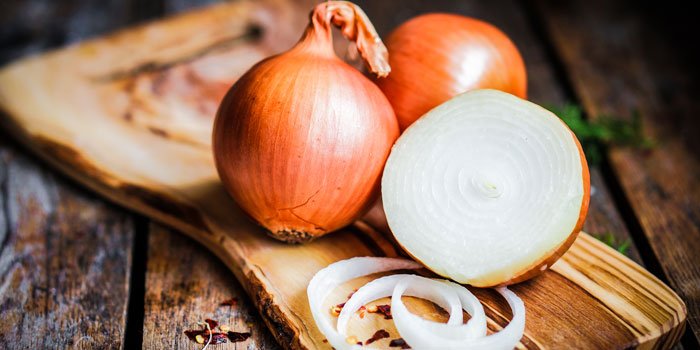
Onions are a cold-season crop, easy to grow because of their hardiness. Onions are planted early in the spring and harvested in the fall after their tops begin to turn yellow and fall over
Using onion sets is recommended, which can be planted without worry of frost damage and have a higher success rate than direct seed or transplants.
Onion plants grow well on raised beds or raised rows at least 4 inches high.

PLANTING
Plant onions as soon as the ground can be worked in the spring, usually late March or April. Make sure temperature doesn’t go below 20 degrees F.
Select a location with full Sun where your onions won’t be shaded by other plants.
Soil needs to be well-drained, loose, and rich in nitrogen; compact soil affects bulb development.
Till in aged manure or fertilizer the fall before planting. Onion plants are heavy feeders and need constant nourishment to produce big bulbs.
At planting time, you can mix in some nitrogen fertilizer, too, and side dress every few weeks until the bulbing process begins.
Seeding? Onion seeds are short-lived. If planting seeds indoors, start with fresh seeds each year. Start seeds indoors about 6 weeks before transplanting.
For sets or transplants, plant the smaller sets 1 inch deep, with 4 to 5 inches between each plant and in rows 12 to 18 inches apart.
Think of onions as a leaf crop, not a root crop. When planting onion sets, don’t bury them more than one inch under the
soil; if more than the bottom third of the bulb is underground, bulb growth can be restricted.
Practice crop rotation with onions.
CARE
Fertilize every few weeks with nitrogen to get big bulbs. Cease fertilizing when the onions push the soil away and the bulbing process has started. Do not put the soil back around the onions; the bulb needs to emerge above the soil.
Generally, onion plants do not need consistent watering if mulch is used. About one inch of water per week (including rain water) is sufficient. If you want sweeter onions, water more.
Onions will look healthy even if they are bone dry, be sure to water during drought conditions.
Make sure soil is well-drained. Mulch will help retain moisture and stifle weeds.
Cut or pull any onions that send up flower stalks; this means that the onions have “bolted” and are done.
PESTS/DISEASES
Thrips: To control thrips—tiny insects about as fat as a sewing needle—take a dark piece of paper into the garden and knock the onion tops against it; if thrips are present, you will spot their tan-colored bodies on the paper. A couple of treatments with insecticidal soap kills them. Follow the package directions. Spray the plants twice, three days apart, and the thrips should disappear.

Onion Maggots: Cover your emerging onion crop with a fine mesh netting. Seal it by mounding soil around the edges. The onion maggot likes to lay its eggs at the base of plants, so the netting should prevent that. You should also keep mulch away because the insects like decaying organic matter, and make sure you completely harvest your onions as the season progresses. Onion maggots are usually a problem in very rainy periods, so these precautions may be unnecessary if you have a dry season.
HARVEST/STORAGE
When onions start to mature, the tops become yellow and begin to fall over. At that point, bend the tops down or even stomp on them to speed the final ripening process.
Loosen the soil to encourage drying, and after a few days turn them up and let them cure on dry ground. Always handle them very carefully—the slightest bruise will encourage rot to set in.
When tops are brown, pull the onions.
Be sure to harvest in late summer, before cool weather. Mature onions may spoil in fall weather.
Allow onions to dry for several weeks before you store them in a root cellar or any other storage area. Spread them out on an open screen off the ground to dry.
Store at 40 to 50 degrees F (4 to 10 degrees C) in braids or with the stems broken off.
Mature, dry-skinned bulbs like it cool and dry.
Don’t store onions with apples or pears, as the ethylene gas produced by the fruits will interrupt the onions’ dormancy.
Onions may also spoil the flavor of these fruits (as well as potatoes).
RECOMMENDED VARIETIES
Onion varieties are classified into two categories: Long-day, best in the North, and short-day, best for the South.
‘Yellow Sweet Spanish’: long-day hybrid, large round shape, yellow-white.
‘Stuttgarter’: short-day variety sold in sets, early maturity with slightly flat shape, yellow.

HEALTH BENEFITS OF ONIONS
The humble onion is found in every kitchen, but its curative powers make it an important medicinal plant too. Like garlic, it is a member of the lily family. There can be no doubting the power of the juices contained in onions; anyone who has ever sliced one and shed a tear is only too aware that they hold something special. Quite apart from its medicinal properties the onion is simply delicious. It forms the basis of so many dishes - whether raw, sautéed, baked, steamed or boiled, that it would be difficult to imagine the cuisine of any country without it.
White onions Ancient healing...
Onions were historically as a preventative medicine during epidemics of cholera and the plague. They were apparently eaten by Roman emperor Nero as a cure for colds, and its reputation has made onions a popular component in the diets of many countries.
...The onion's revenge: The smell of onions can be a problem, both on the hands and on the breath. After chopping onions, try rinsing the hands with cold water, rubbing them with salt, rinsing again and then washing with soap and warm water. To remove the smell from breath, eat a few sprigs of parsley or an apple to help conceal the odour.
Nutritional highlights
More than just a tasty culinary plant, the onion contains natural sugar, vitamins A, B6, C and E, minerals such as sodium, potassium, iron and dietary fibre. In addition, onions are a good source of folic acid.
44 calories 1.4g fibre
100g serving of onions contains
The power of raw...
Raw onionThe reason that the onion is so much more active in its raw state than when cooked, is that it contains a variety of organic sulphur compounds, contained in a volatile oil, that provide the health benefits. These are partly destroyed by heat. When eaten raw, its juice can act as an irritant and some people find it difficult to digest. Those who are not tempted by the idea of eating raw onions can follow simple cooking methods that may make them more palatable. For people with sensitive stomachs, this is a far suitable way to enjoy the healthy benefits of onions. Onions baked in their skins, in a similar way to baked potatoes, are also delicious. This method of cooking keeps all the goodness inside, but the resulting flavour is milder and more aromatic than that of raw onions.
...Red onions: rubbed on warts or verrucas are thought by some to encourage them to disappear. In some Arab countries onions mixed with salt and pepper are applied to the scalp as a remedy for hair loss.
Research
Although not nearly as valued a medicinal agent as garlic, onion has been used almost as widely. Onions have been used in folk medicine for the relief of coughs, colds and catarrh, especially asthma, but more recently some of their curative properties have been attributed to a compound called allyl propyl disulphide, which is thought to have a similar effect to insulin in balancing blood sugar levels. This does not mean that the onion can be used as a substitute for insulin therapy; but it may be of help to those who suffer from hypoglycaemia. If you suffer from hypoglycaemia consult your doctor if you have any nutritional queries.
Red onionTypes of onions
Onions differ in the size, colour and taste. Spring onions are grown in warmer climates and have a milder, sweeter taste. Storage onions are grown in colder weather climates and generally have a more pungent flavour and are usually named by their colour: white, yellow or red. Smaller onions come in many types, such as chives, leeks and shallots.
How to select and store
Globe onions should be clean and hard and have dry, smooth skins. Avoid onions in which the seen stem has developed. Also avoid those that show signs of decay. Onions should be stored at room temperature, away from bright light and in a well ventilated area. Those that are more pungent in flavour such as yellow onions, will keep longer than those with a sweeter tastes such as white onions, since the compounds that produce the sharp taste are natural preservatives as well. All onions should be stored away from potatoes, as they will absorb their moisture and ethylene gas, causing potatoes to spoil more easily. Do not store cooked onions in a metal bowl or storage container as this will cause them to discolor. Freezing chopped onions will cause them to lose much of their flavour.
_Cry me a river... _
...the compound allyl sulphate which is produced when an onion's ruptured cells are exposed to air is responsible for producing tears. To reduce the production of this compound, chill the onions for half an hour or so before cutting to reduce the activity of the enzyme.

Recipe suggestions
Onions feature as the basis of many classic recipes worldwide. Here are just a few ideas:
Cheese & onion is a partnership not just for crisps:
Easy cheese & onion slice
Cheese & onion pork chopS
Caramelised onion & feta pizzas
Cheese & onion soufflé tart
Onion transforms gravy:
Sausages with sticky onion gravy
Sausages with quick onion gravy
Raw onions for the brave and the bold:
Tuna & red onion salad
Tomato & onion salad
Onion soups:
Pea, mint & spring onion soup with Parmesan biscuits
Caramelised onion & barley soup with cheese croutons
Onion soup with herby garlic cheese bread
And let's not forget the classic onion ring!
Crispy Cajun onion rings

Hi! I am a robot. I just upvoted you! I found similar content that readers might be interested in:
https://www.almanac.com/plant/onions